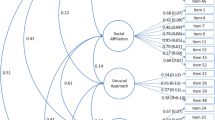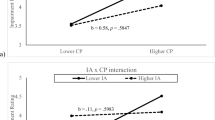Abstract
The Nisonger Child Behavior Rating Form (NCBRF) is a behavior rating scale designed for children and adolescents with mental retardation. The purpose of this study was to explore the psychometric properties of the NCBRF in a sample of 330 children and adolescents with autism spectrum disorders (ASDs). Parent and teacher ratings were independently submitted to both exploratory and confirmatory factor analysis. As reported with the original validation study, parent and teacher versions shared similar but somewhat different factor structures. Social competence items showed more similarity with the original solutions than did problem behavior items. Problem behavior items were distributed into a somewhat simpler five-factor solution for both rating forms. Self-injurious and stereotypic items loaded on two distinct subscales for the teacher form, but not on the parent form. Factor loadings and internal consistencies were generally lower than those reported for the original versions but still within the acceptable range. Confirmatory factor analyses indicated good fits for the social competence items and acceptable fits for the problem behavior items. Overall, results supported the construct validity of the NCBRF in children and adolescents with ASDs.
Similar content being viewed by others
References
Achenbach, T. M. (1991). Manual for the CBCL/4-18 and profile. Department of Psychiatry, University of Vermont: Author.
T. M. Achenbach S. H. McConaughy C. T. Howell (1987) ArticleTitleChild/adolescent behavioral and emotional problems: Implications of cross-informant correlations for situational specificity Psychological Bulletin 101 213–232
M. G. Aman (1991) Assessing psychopathology and behavior problems in persons with mental retardation: A review of available instruments U.S. Department of Health and Human Services Rockville, MD
M. G. Aman N. N. Singh A. W. Stewart C. J. Field (1985a) ArticleTitleThe Aberrant Behavior Checklist: A behavior rating scale for the assessment of treatment effects American Journal on Mental Deficiency, 89 485–491
M. G. Aman N. N. Singh A. W. Stewart C. J. Field (1985b) ArticleTitlePsychometric characteristics of the Aberrant Behavior Checklist American Journal on Mental Deficiency, 89 492–502
M. G. Aman M. J. Tassé J. Rojahn D. Hammer (1996) ArticleTitleThe Nisonger CBRF: A child behavior rating form for children with developmental disabilities Research in Developmental Disabilities 17 41–57
L. B. Behar S. A. Stringfield (1974) ArticleTitleA behavior rating scale for the preschool child Developmental Psychology 10 601–610
P. M. Bentler D. G. Bonett (1980) ArticleTitleSignificance tests and goodness of fit in the analysis of covariance structures Psychological Bulletin 88 588–606
S. B. Berument M. Rutter C. Lord A. Pickles A. Bailey (1999) ArticleTitleAutism screening questionnaire: Diagnostic validity British Journal of Psychiatry 175 444–451
J. W. Bodfish T. W. Crawford S. B. Powell D. E. Parker R. N. Golden M. H. Lewis (1995) ArticleTitleCompulsions in adults with mental retardation: Prevalence, phenomenology, and comorbidity with stereotypies and self-injury American Journal on Mental Retardation 100 183–192
J. W. Bodfish F. J. Symons D. E. Parker M. H. Lewis (2000) ArticleTitleVarieties of Repetitive Behavior in Autism: Comparisons to Mental Retardation Journal of Autism and Developmental Disorders 30 237–243
E. C. Brown M. G. Aman S. M. Havercamp (2002) ArticleTitleFactor analysis and norms for parent ratings on the Aberrant Behavior Checklist-Community for young people in special education Research in Developmental Disabilities 23 45–60
M. W. Browne R. Cudeck (1993) Alternative ways of assessing model fit. K. A. Bollen J. Scott Lang (Eds) Testing structural models Sage Publications Newbury park, CA 136–162
C. K. Conners (1997) Conners’ Rating Scales-Revised Technical Manual. Multi-Health Systems North Tanawanda, NY
C. S. Edelbrock (1985) ArticleTitleChild Behavior Rating Form Psychopharmacological Bulletin. 21 835–837
S. Ehlers C. Gillberg (1993) ArticleTitleThe epidemiology of Asperger syndrome: A total population study Journal of Child Psychology and Psychiatry and Allied Disciplines 34 1327–1350
S. Ehlers C. Gillberg L. Wing (1999) ArticleTitleA screening questionnaire for Asperger syndrome and other high functioning autism spectrum disorders in school age children Journal of Autism and Developmental Disorders 29 129–141
S. L. Einfeld B. J. Tonge (1995) ArticleTitleThe Developmental Behaviour Checklist: The development and validation of an assessment of behavioural and emotional disturbance in children and adolescents with mental retardation Journal of Autism and Developmental Disorders 25 81–104
S. L. Einfeld B. J. Tonge (2002) Manual for the Developmental Behaviour Checklist. Monash University Center for Developmental Psychiatry and School of Psychiatry, University of New South Wales Clayton, Malbourne, and Aydney
F. Floyd K. F. Widaman (1995) ArticleTitleFactor analysis in the development and refinement of clinical assessment instruments Psychological Assessment 7 286–299
J. E. Gilliam (1995) Gilliam Autism Rating Scale ProEd Austin, Texas
J. E. Gilliam (2001) Gilliam Asperger’s Disorder Scale ProEd Austin, Texas
E. Guadagnoli W. Velicer (1988) ArticleTitleRelation of sample size to the stability of component patterns Psychological Bulletin 103 265–275
R. P. Hastings T. Brown R. H. Mount Magnus K.F. Cormack (2001) ArticleTitleExploration of the psychometric properties of the Developmental Behavior Checklist Journal of Autism and Developmental Disorders 31 423–431
M. Kohn B. L. Roseman (1972) ArticleTitleA social competence scale and symptom checklist for the preschool child: Four dimensions, their cross-instrument generality, and longitudinal persistence Developmental Psychology 6 430–444
D. A. Krug J. Arick P. Almond (1980) ArticleTitleBehavior checklist for identifying severely handicapped individuals with high levels of autistic behavior Journal of Child Psychology and Psychiatry and Allied Disciplines 21 221–229
M. H. Lewis J. W. Bodfish (1998) ArticleTitleRepetitive behavior disorders in autism Mental Retardation and Developmental Disabilities Research Reviews 4 80–89
C. Lord M. Rutter A. Le Couteur (1994) ArticleTitleThe Autism Diagnostic Interview–Revised: A revised version of a diagnostic interview for caregivers of individuals with possible pervasive developmental disorders Journal of Autism and Developmental Disorders 24 659–685
O. C. Mudford B. A. Cross S. Breen C. Cullen D. Reeves J. Gould J. Douglas (2000) ArticleTitleAuditory integration training for children with autism: No behavioral benefits detected American Journal on Mental Retardation 105 118–129
J. T. Newton P. Sturmey (1988) ArticleTitleThe Aberrant Behavior Checklist: A British replication and extension of its psychometric properties Journal of Mental Deficiency Research 32 87–92
J. C. Nunnally (1978) Psychometric theory EditionNumber2 McGraw–Hill New York, NY
S. Reiss D. Valenti-Hein (1994) ArticleTitleDevelopment of a psychopathology rating scale for children with mental retardation Journal of Consulting and Clinical Psychology 62 28–33
C. R. Reynolds R. W. Kamphaus (1998) Manual for the Behavior Assessment System for Children. American Guidance Service Circle Pines, MN
J. Rojahn W. J. Helsel (1991) ArticleTitleThe Aberrant Behavior Checklist in children and adolescents with dual diagnosis Journal of Autism and Developmental Disorders 21 17–28
Rush, A. J., & Frances, A. (2000). Special Issue: Expert consensus guideline series: Treatment of psychiatric and behavioral problems in mental retardation. American Journal on Mental Retardation, 105.
M. Rutter (1970) ArticleTitleAutistic children: Infancy to adulthood Seminars in Psychiatry 2 435–450
E. Schopler R. J. Reichler R. F. DeVellis K. Daly (1980) ArticleTitleToward objective classification of childhood autism: Childhood Autism Rating Scale (CARS) Journal of Autism and Developmental Disorders 10 91–103
J. Stevens (2002) Applied multivariate statistics for the social sciences EditionNumber4 Lawrence Erlbaum Associates Mahwah, N. J
M. J. Tassé N. Girouard I. N. Morin (2000) ArticleTitleFrench Canadian translation and validation of the Nisonger Child Behavior Rating Form Canadian Psychology 41 116–123
M.J. Tassé L. Lecavalier (2000) ArticleTitleComparing parent and teacher ratings of social competence and problem behavior American Journal on Mental Retardation 105 252–259
M. J. Tassé M. G. Aman D. Hammer J. Rojahn (1996) ArticleTitleThe Nisonger Child Behavior Rating Form: Age and gender effects and norms Research in Developmental Disabilities 17 59–75
B. J. Tonge S. L. Einfeld (2003) Psychopathology and intellectual disability: The Australian child to adult longitudinal study L. M. Glidden (Eds) International Review of Research in Mental Retardation, 26, 61–91 Academic Press San Diego, CA
Author information
Authors and Affiliations
Rights and permissions
About this article
Cite this article
Lecavalier, L., Aman, M.G., Hammer, D. et al. Factor Analysis of the Nisonger Child Behavior Rating Form in Children with Autism Spectrum Disorders. J Autism Dev Disord 34, 709–721 (2004). https://doi.org/10.1007/s10803-004-5291-1
Issue Date:
DOI: https://doi.org/10.1007/s10803-004-5291-1




